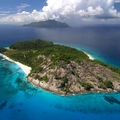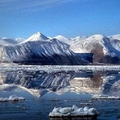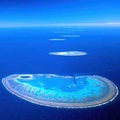World Tourism / The Oceans of the World / The Arctic Ocean
The Arctic Ocean
The Arctic Ocean- the realm of ice and silence
The Arctic Ocean, which lies between Canada and Siberia, is the smallest ocean on the planet. It is the most mysterious, because it is almost completely hidden under a huge layer of ice. The Arctic Ocean basin divides into two underwater thresholds. The Arctic basin is larger and it is the deepest ocean. It is 5000 meters and it is located north of Franz Josef Land. Besides the Russian coast, it is a vast continental shelf. For this reason the Arctic seas, namely the Kara, the Barents, the Laptev, the Chukchi,the East Siberian are shallow.
Description
The beaches in the west of Eurasia are predominantly high. Deltoid and lagoons are in the east, in the Canadian Arctic Archipelago - mostly low and flat. The Eurasian coast is washed by the seas: the Norwegian, Barents, White, Kara, Hudson Bay, bays and straits of the Canadian Arctic Archipelago. By the number of islands, the Arctic Ocean is the second after the Pacific Ocean. The largest islands and the archipelagos in the ocean are of continental origin. Ninety percent of the space of the Arctic Ocean is covered by four-meter layer of ice. In Baffin Bay are particularly frequent icebergs and the so-called "ice islands" whose thickness reaches 45 meters. They are easy to install on their drifting research stations that are actively engaged in research work: make a map of the ocean floor, exploring the flora and fauna. Often the photos from the Arctic Ocean research stations come online and then we can experience firsthand the beauty and the danger of the harsh edges. Many people mistakenly confuse the Arctic Ocean from the Southern Ocean surrounding Antarctica, from the similarity of the climates of the oceans. In other oceans, the development of navigation, the speed and the direction of currents can be determined by the deviation of the ship. In the Arctic, few data on currents were obtained by observing the movement of the ice frozen in the courts. In 1893 Fridtjof Nansen on his small ship "Fram" entered the pack ice north of the coast of Siberia, hoping to reach the North Pole with the drifting ice. However, it appeared that the trajectory of this ice was held in 480 km from the pole, and then Nansen left the "Fram" and headed to the North Pole on foot. He reached up to 86 ° N 14ў and turned back. The ship same icebound, drifted for three years and nearly reached Spitzbergen. In those parts of the ocean, which are covered with ice all the year round, the flora and the fauna is very scanty, as the ice transmits light poorly, hindering the growth of plants. More open parts of the ocean are abundant in seals, polar bears, whales and many species of fish.
Cognitive information
The average depth of the Pacific Ocean is of 4,000 m. More than 3% of the composition of ocean water is dissolved into mineral salts. The salt water is much easier to navigate than in fresh water. It is very easy to stay on the surface of the Dead Sea in the Middle East, as its water contains about 24% of salt. More gold than in all the banks in the world are in the waters of the ocean. But it is dissolved in water, and for 400 000 000 000 particles of water is brought only a piece of gold, or about 4 grams per million tons of water. For this reason, it is very difficult to obtain. Besides gold, the sea water contains silver, sulfur, and calcium.
The most mysterious and amazing sea views
The most surprising thing on the Earth is the Sar-gassovoe Sea, which is located in the Atlantic Ocean off the coast of North America. This is the only sea which has no coasts. The entire surface is covered with algae. That’s why, the sea has such a name. The Sargassum is not spread throughout the sea, because they keep the flow. Bubbles, like berries are floating at each algae. With their help, algae can swim across the sea, but still carry on its "passengers": small clams or crabs. The depths of the sea have many interesting things about the past. In 1956, on the depth of the sea was discovered a Swedish warship "Vasa" which sank in 1628 in Stockholm. Now, it is preserved with special chemicals in a dry dock. The ship "Mary Rose", which belonged to the King of England Henry VIII, sank in 1545. The ship was found only in 1967 and in 1982 it was removed to the surface. The remains of the ship became important sources of information about the ancient life in England in the XVI century. The sea water retained even such things as first-aid hiking and cooking utensils. In the mid-90s, in the XX century, the port of Alexandria in Egypt was explored and many statues of Cleopatra were found. Among the most interesting archaeological findings were the remains of a grand Faroese lighthouse, considered one of the seven wonders of the world. The superficial ocean currents sometimes reach 80 km in width and can run up to 220 km per day. The Antarctic Circumpolar Current, which bathes the Antarctic, carries 130 million cubic meters. Its volume is 2000 times greater than the volume of the water in the deep Amazon river. The powerful Gulf Stream runs like a great river to the Atlantic Ocean. It carries the water volume 20 times more than all the combined rivers of the globe. Together with the North Atlantic and other trends, it is like "central heating" of Europe, the Northern Hemisphere. The Gulf Stream carries the waters of the Gulf of Mexico to the Scandinavian peninsula, freeing the way for the ice-British Isles. Therefore, the climate is milder than in northern Canada, although they are on the same latitude.
Why the port of Murmansk is ice?
The Russian port of Murmansk is ice even in the coldest winter polar waters warm thanks also the North Atlantic Current. The highest wave of all who watched the high seas was discovered during a storm in 1933 with the ship. Its height is of 34 m.
What is the "Bermuda Triangle"?
In the late 70's. , the XX century much attention was paid to the so-called Bermuda Triangle. At this point, though mysteriously many ships and aircrafts disappeared. The Bermuda Triangle is a space in the shape of a triangle in the Atlantic Ocean between the Florida peninsula, the islands of Puerto Rico and Bermuda. The tragedy that occurred here, attributed to some unknown force. As a U.S. newspaper wrote: " on the 1 st of February, in 1972, a huge tanker disappeared in the Gulf of Mexico. The vessel found only on the 14 th of February at the bottom. All the 38 crew members had disappeared. But what was the most amazing was that the captain of the tanker was found in his cabin sitting at the table with his hand in a coffee cup. " The following questions appeared: Why didn’t the ship give a distress signal? Where is the crew? The above description of the incident was widely distributed in media around the world. But the scientist LD Kush decided to investigate, to solve this puzzle. In one of the newspapers that wrote about the incident, he found the facts from which it follows that on the "Vogt" was an explosion, and there is anything supernatural. A careful scientist found a message, which said that the corpses of the victims had been found and that the captain was killed in the chart house, and his body was found there. The story of the mysterious cup of coffee is a perfect nonsense. Thus, many mysterious accidents that occurred in the Bermuda Triangle were investigated. As a result, it remains unclear, only a few accidents, of which the scientist simply could not find enough information.
In addition, these accidents occur in any area of the oceans, and the Bermuda Triangle has nothing to do with it. But, it is undeniable that the number of accidents at this location is actually higher than in other parts of the world's oceans. But it is mainly due to the fact that there is very high intensity of shipping and air travel. In addition, the Bermuda Triangle has more complex hydrometeorologic conditions for the flights and cruises that are related to the influence of the warm waters of the Gulf Stream. As well as the mystery of accidents can be attributed to the relatively strong current. It quickly kills the wreckage of ships in distress. Hence, the illusion of their complete disappearance.
Others The Oceans of the World .
Maps of The Arctic Ocean
mapOthers from The Oceans of the World
Life depends crucially, more than ever, on the respect that people will have to the oceans.
They are and will remain the cradle of life.
A romance voyage with saturated air, breathing the sea air is a necessary condition for a quality rest.
This improves the immunity of the person and receives a charge of vivacity enough for a few months.
The sea air, rich in iodine salts, sodium chloride promotes cell regeneration and the slowing of the aging process.
The sea calms, the sound of the waves, and the vast expanse of the water that a person can watch endlessly is good for our health.
When combined with new experiences, excursions and trips, sea and ocean tours give a great therapeutic effect.
The oceans and the seas, the rivers, the lakes and the streams cover 75% of the surface of our planet.
The amazing underwater world attracts many travelers.
In the past, a travel was associated with the seas and oceans.
Geographical discoveries are inextricably linked with the travelers.
The world knows them since the Middle Ages and starting the list with Columbus and ending with Heyerdalom and Jacques-Yves Cousteau.
Hydrosphere is the collection of all water bodies of the world: oceans , rivers , lakes , reservoirs, wetlands, groundwater, glaciers.
Water is the basis of the hydrosphere, one of the most common chemical compounds on the Earth.
This is the only substance that under natural conditions on the surface of our planet is found in solid, liquid or gaseous state.
It is the main component of the living organisms.
Water body is the permanent or the temporary concentration of the natural waters on the land surface or in rocks with distinctive forms of distribution and features of the regime.
Water bodies are the seas, oceans, rivers, lakes, marshes, reservoirs, groundwater, and water channels, ponds and other places of constant concentration of water on the land surface (in the form of snow).
The world ocean is the bulk of the hydrosphere, a continuous aqueous envelope of the earth surrounding the continents and islands distinguished by a salt composition.
The oceans are regulators of the heat.
Oceans are rich in food, mineral and energy resources.
The boundaries between oceans have been established by the International Hydrographic Organization , so the Antarctic Ocean coast extends from Antarctica to 60 degrees latitude.
One billion people ( 17% of the population) depend directly on the ocean as the only source of protein.
Between 70 – 80% of oxygen is produced by the oceans.
The word ocean from the Greek “ Ωκεανός” , on behalf of the Greek god of the Ocean is the largest water body, a component of the World Ocean , located among the continents , which has a system of water circulation and other special features.
The surface area of the world's oceans, which consist of oceans and seas is about 75 % of the surface of the Earth (about 361 million square kilometers).
The science that studies the oceans is called oceanography .
In 2000, the International Hydrographic Organization adopted a division into five oceans of the world .
However, later on the provision of a separate Southern Ocean refused, and it is now officially back on the Earth’s four oceans: The Atlantic Ocean Area: 91 million km 2 Size: 329.
7 million km 3 Average depth: 3600 meters Maximum depth: 8742 meters The Indian Ocean Area: 73 million km 2 Volume: 292.
1 km 3 Average depth: 3890 meters Maximum depth: 7725 meters The Arctic Ocean Area: 14 000 000 km 2 Volume: 18.
1 km 3 Average depth: 1225 meters Maximum depth: 5527 meters The Pacific Ocean Area: 169 million km 2 Size: 710 km 3 Average depth: 4280 meters Maximum depth: 11 022 m The largest of these is the Pacific Ocean, an area of approximately 169 million square km, the Atlantic Ocean, which area is 91 million square km is the third largest ocean, the Indian and the smallest ocean - the Arctic, an area of approximately 14 million square km.
The oceans are deep waters.
If the surface of the ocean is warmed up by the sun, at the depth, its temperature can fall and fall , even below -1 C.
The water in all parts of the vast ocean is never quiet, constantly moving.
Such movements of the water over long distances are called currents.
The currents are of several types: superficial, deep and bottom.
The main reason for the surface currents (drift) is a breeze.
The sun, the chemical transformations and the attraction of the moon are reasons for the movement of water in the ocean.
The colder or the saltier water .
So, for example, when dealing with warm water, the cold goes into the depths.
Thus deep and bottom currents can be formed.
The Russian Admiral Makarov scientist discovered in the XIX century an undercurrent in the Bosporus.
He found that the more saline waters of the Marmara Sea flows into the Black Sea current , less saline water is carried by the current from the Black Sea of Marmara.
There are ocean currents that arise due to the inclination of the sea level.
These include, in particular, to Florida for the Caribbean, which is formed as a result of the surge of the water over the surface in the Gulf of Mexico.
We cannot know the answer to the question about the formation of the seas and oceans on the planet.
Some scholars suggest that they arose in the following way.
After the appearance of the planet, the Earth was surrounded by a thick blanket of clouds.
Gradually, the Earth cooled and long rains poured on the surface, which filled with water all the cavities in the earth's crust.
Thus, the oceans and the seas were formed.
Later, when the continents began to move, all moving from each other, the water began to fill the distance between them.
So they formed the oceans, which are available now.










